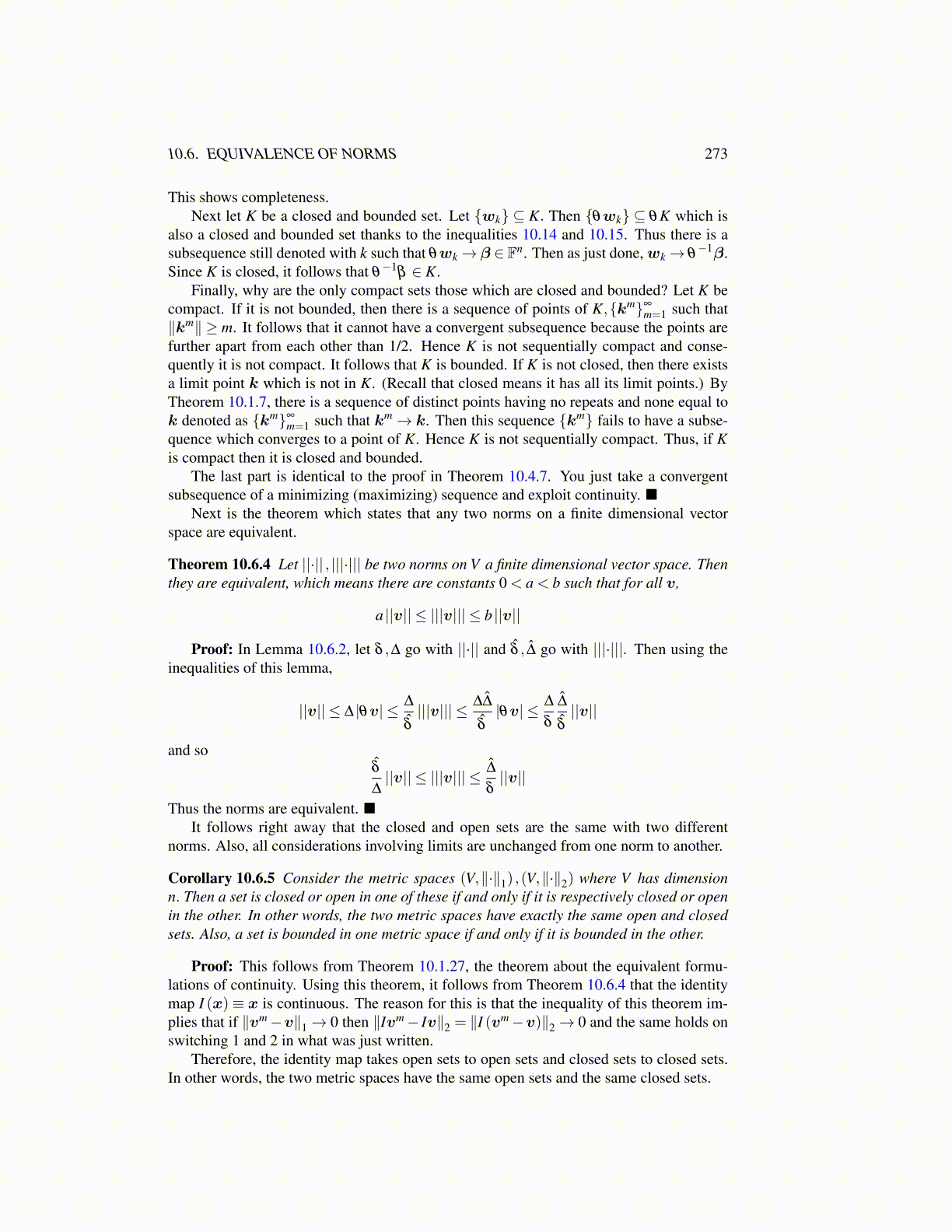
10.6. EQUIVALENCE OF NORMS 273
This shows completeness.Next let K be a closed and bounded set. Let {wk} ⊆ K. Then {θwk} ⊆ θK which is
also a closed and bounded set thanks to the inequalities 10.14 and 10.15. Thus there is asubsequence still denoted with k such that θwk→ β ∈ Fn. Then as just done, wk→ θ
−1β.Since K is closed, it follows that θ
−1β ∈ K.
Finally, why are the only compact sets those which are closed and bounded? Let K becompact. If it is not bounded, then there is a sequence of points of K,{km}∞
m=1 such that∥km∥ ≥ m. It follows that it cannot have a convergent subsequence because the points arefurther apart from each other than 1/2. Hence K is not sequentially compact and conse-quently it is not compact. It follows that K is bounded. If K is not closed, then there existsa limit point k which is not in K. (Recall that closed means it has all its limit points.) ByTheorem 10.1.7, there is a sequence of distinct points having no repeats and none equal tok denoted as {km}∞
m=1 such that km→ k. Then this sequence {km} fails to have a subse-quence which converges to a point of K. Hence K is not sequentially compact. Thus, if Kis compact then it is closed and bounded.
The last part is identical to the proof in Theorem 10.4.7. You just take a convergentsubsequence of a minimizing (maximizing) sequence and exploit continuity. ■
Next is the theorem which states that any two norms on a finite dimensional vectorspace are equivalent.
Theorem 10.6.4 Let ||·|| , |||·||| be two norms on V a finite dimensional vector space. Thenthey are equivalent, which means there are constants 0 < a < b such that for all v,
a ||v|| ≤ |||v||| ≤ b ||v||
Proof: In Lemma 10.6.2, let δ ,∆ go with ||·|| and δ̂ , ∆̂ go with |||·|||. Then using theinequalities of this lemma,
||v|| ≤ ∆ |θv| ≤ ∆
δ̂|||v||| ≤ ∆∆̂
δ̂|θv| ≤ ∆
δ
∆̂
δ̂||v||
and soδ̂
∆||v|| ≤ |||v||| ≤ ∆̂
δ||v||
Thus the norms are equivalent. ■It follows right away that the closed and open sets are the same with two different
norms. Also, all considerations involving limits are unchanged from one norm to another.
Corollary 10.6.5 Consider the metric spaces (V,∥·∥1) ,(V,∥·∥2) where V has dimensionn. Then a set is closed or open in one of these if and only if it is respectively closed or openin the other. In other words, the two metric spaces have exactly the same open and closedsets. Also, a set is bounded in one metric space if and only if it is bounded in the other.
Proof: This follows from Theorem 10.1.27, the theorem about the equivalent formu-lations of continuity. Using this theorem, it follows from Theorem 10.6.4 that the identitymap I (x)≡ x is continuous. The reason for this is that the inequality of this theorem im-plies that if ∥vm−v∥1→ 0 then ∥Ivm− Iv∥2 = ∥I (vm−v)∥2→ 0 and the same holds onswitching 1 and 2 in what was just written.
Therefore, the identity map takes open sets to open sets and closed sets to closed sets.In other words, the two metric spaces have the same open sets and the same closed sets.